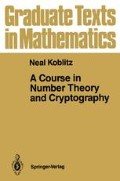Abstract
Recall that a cryptosystem consists of a 1-to-1 enciphering transformation f from a set P of all possible plaintext message units to a set C of all possible ciphertext message units. Actually, the term “cryptosystem” is more often used to refer to a whole family of such transformations, each corresponding to a choice of parameters (the sets P and C, as well as the map f, may depend upon the values of the parameters). For example, for a fixed N-letter alphabet (with numerical equivalents also fixed once and for all), we might consider the affine cryptosystem (or “family of cryptosystems”) which for each a ∊ (Z/NZ)* and b ∊ Z/NZ is the map from P = Z/NZ to C = Z/NZ defined by C = aP + b mod N. In this example, the sets P and C are fixed (because N is fixed), but the enciphering transformation f depends upon the choice of parameters a, b. The enciphering transformation can then be described by (i) an algorithm, which is the same for the whole family, and (ii) the values of the parameters. The values of the parameters are called the enciphering key K E . In our example, K E is the pair (a, b). In practice, we shall suppose that the algorithm is publicly known, i.e., the general procedure used to encipher cannot be kept secret. However, the keys can easily be changed periodically and, if one wants, kept secret.
Access this chapter
Tax calculation will be finalised at checkout
Purchases are for personal use only
Preview
Unable to display preview. Download preview PDF.
References for § IV.1
M. Blum, “Coin-flipping by telephone — a protocol for solving impossible problems,” IEEE Proceedings‚ Spring Compcon., 133–137.
W. Diffie and M. E. Heilman, “New directions in cryptography,” IEEE Transactions in Information Theory IT-22 (1976), 644–654.
M. E. Heilman, “The mathematics of public-key cryptography,” Scientific American‚ vol. 241 (1979), 146–157.
E. Kranakis, Primality and Cryptography‚ John Wiley & Sons, 1986.
G. Ruggiu, “Cryptology and complexity theories,” Advances in Cryptology, Proceedings of Eurocrypt 84, Springer, 1985, 3–9.
References for § IV.2
L. M. Adleman, R. L. Rivest and A. Shamir, “A method for obtaining digital signatures and public-key cryptosystems,” Communications of the ACM‚ vol. 21 (1978), 120–126.
R. L. Rivest, “RSA chips (past/present/future),” Advances in Cryptology‚ Proceedings of Eurocrypt 84, Springer, 1985, 159–165.
J. A. Gordon, “Strong primes are easy to find,” Advances in Cryptology, Proceedings of Eurocrypt 84‚ Springer, 1985, 216–223.
References for § IV.3
L. M. Adleman, “A subexponential algorithm for the discrete logarithm problem with applications to cryptography,” Proceedings of the 20th Annual Symposium on the Foundations of Computer Science (1979), 55–60.
D. Coppersmith, “Fast evaluation of logarithms in fields of characteristic two,” IEEE Transactions in Information Theory IT-30 (1984), 587–594.
References for § IV.4
M. R. Garey and D. S. Johnson, Computers and Intractability: A Guide to the Theory of NP-Completeness, W. H. Freeman, 1979.
R. M. F. Goodman and A. J. McAuley, “A new trapdoor knapsack public key cryptosystem,” Advances in Cryptography, Proceedings of Eurocrypt 84, Springer, 1985, 150–158.
M. E. Heilman, “The mathematics of public-key cryptography,” Scientific American‚ vol. 241 (1979), 146–157.
M. E. Heilman and R. C. Merkle, “Hiding information and signatures in trapdoor knapsacks,” IEEE Transactions in Information Theory IT-24 (1978)‚ 525–530.
A. Shamir, “A polynomial time algorithm for breaking the basic Merkle- Hellman cryptosystem,” Proceedings of the 23rd Annual Symposium on the Foundations of Computer Science (1982), 145–152.
Author information
Authors and Affiliations
Rights and permissions
Copyright information
© 1987 Springer-Verlag New York Inc.
About this chapter
Cite this chapter
Koblitz, N. (1987). Public Key. In: A Course in Number Theory and Cryptography. Graduate Texts in Mathematics, vol 114. Springer, New York, NY. https://doi.org/10.1007/978-1-4684-0310-7_4
Download citation
DOI: https://doi.org/10.1007/978-1-4684-0310-7_4
Publisher Name: Springer, New York, NY
Print ISBN: 978-1-4684-0312-1
Online ISBN: 978-1-4684-0310-7
eBook Packages: Springer Book Archive

